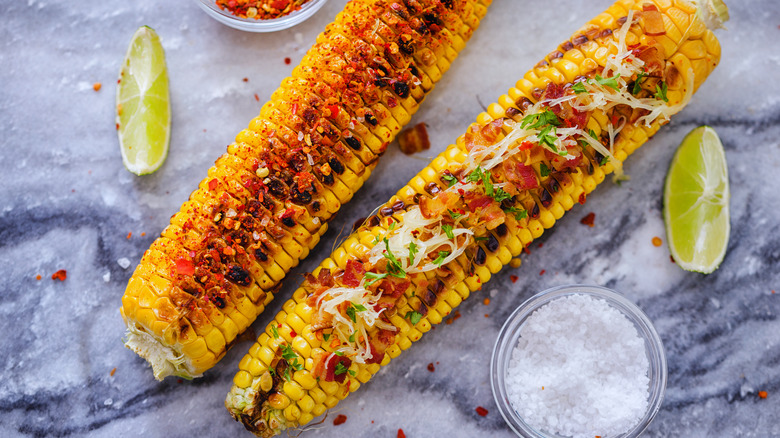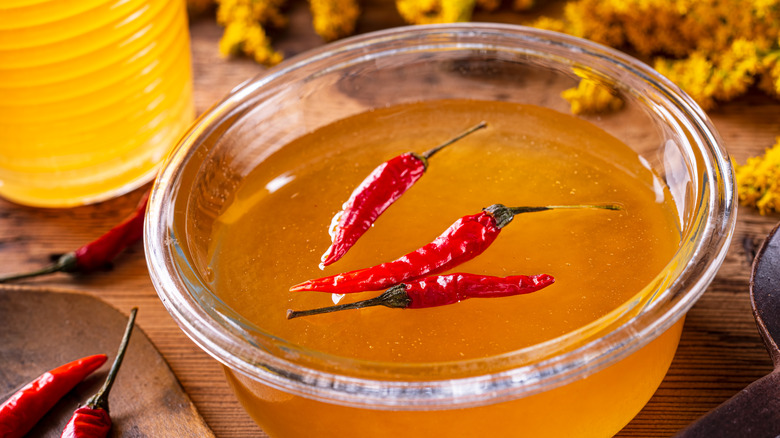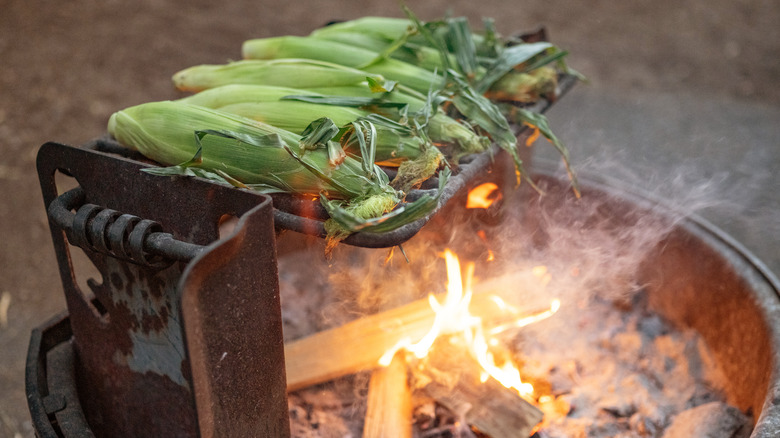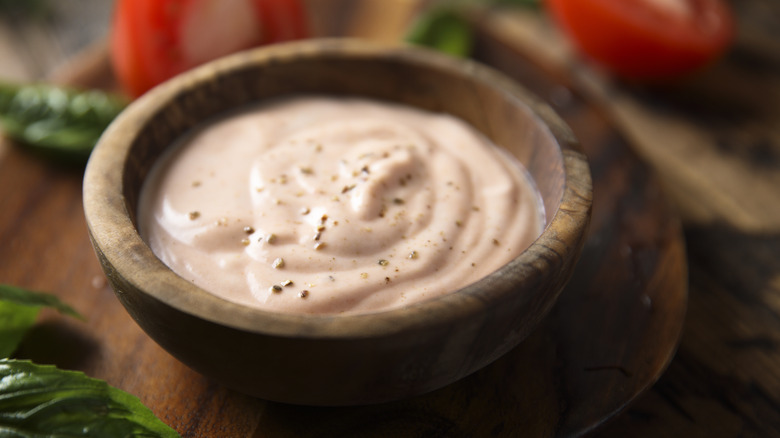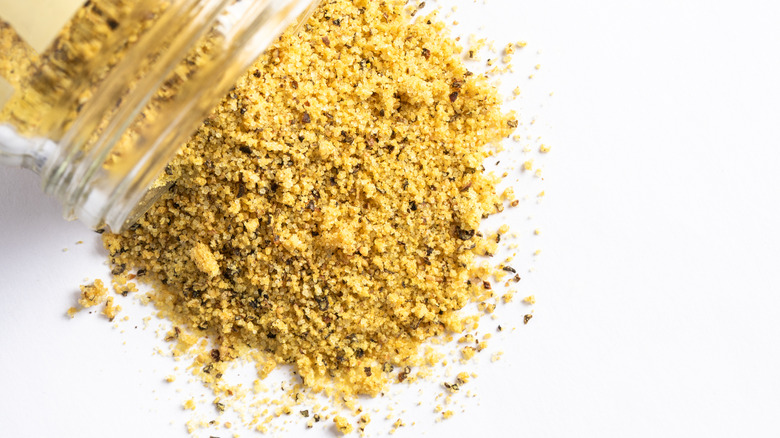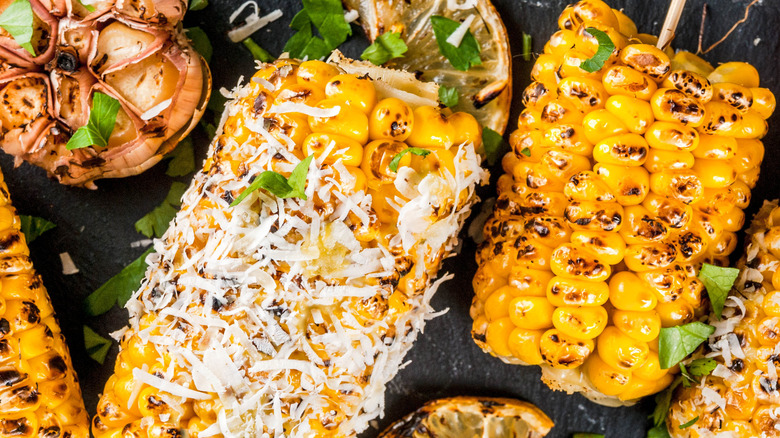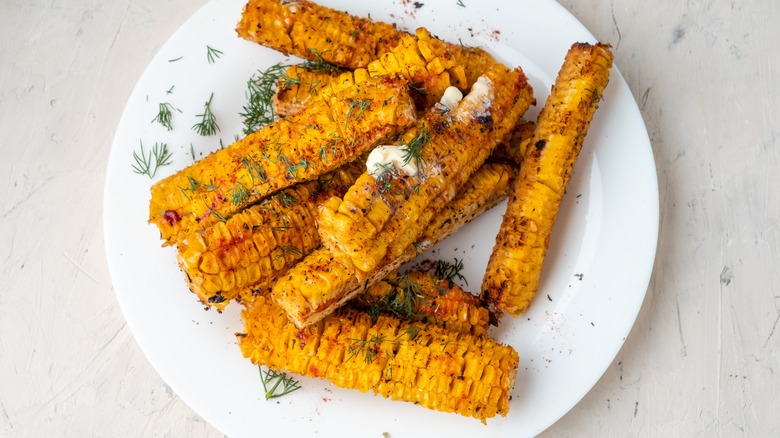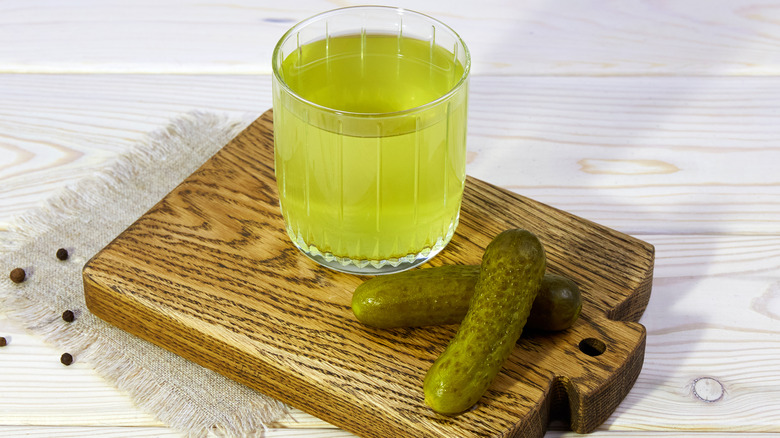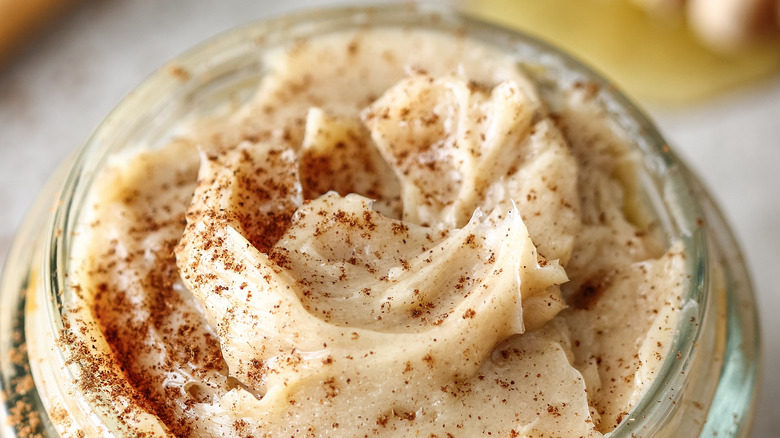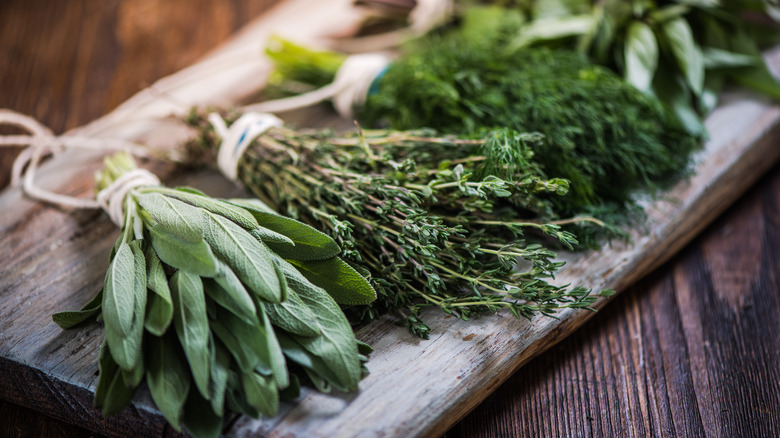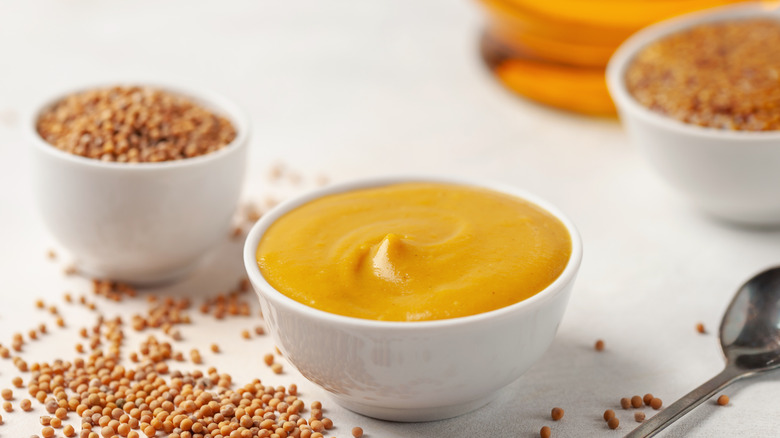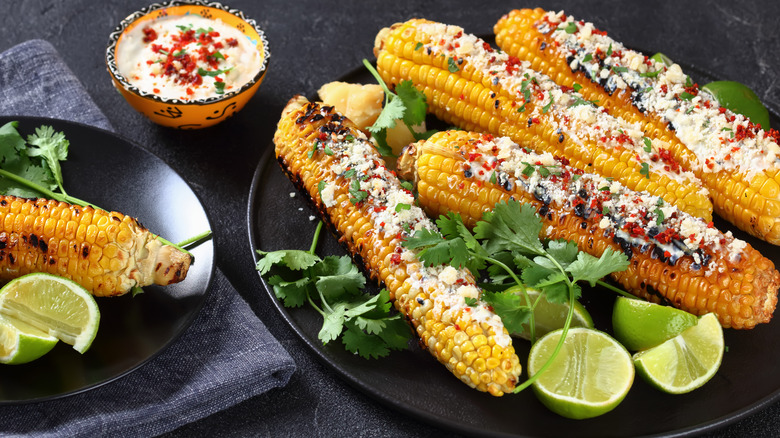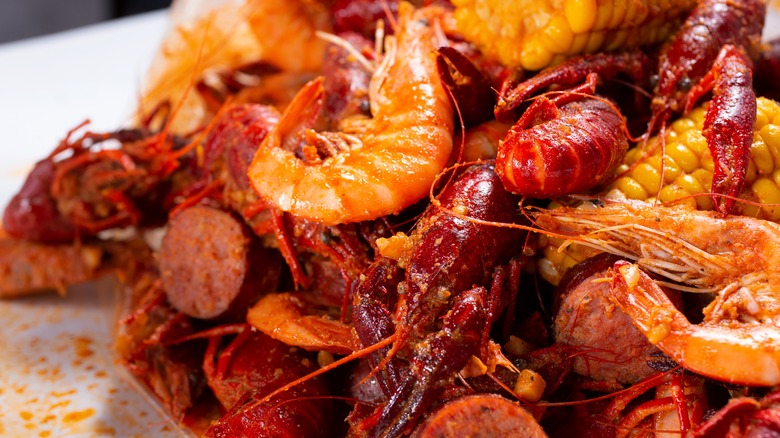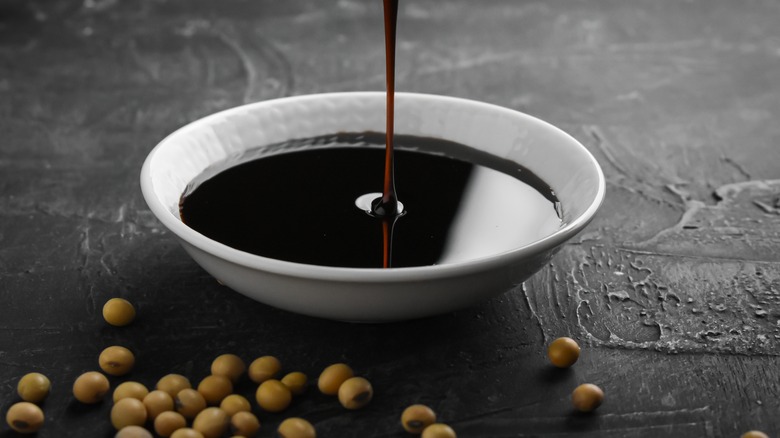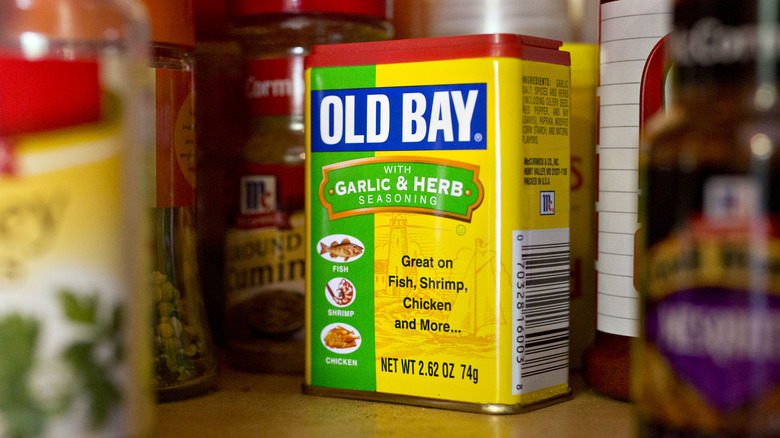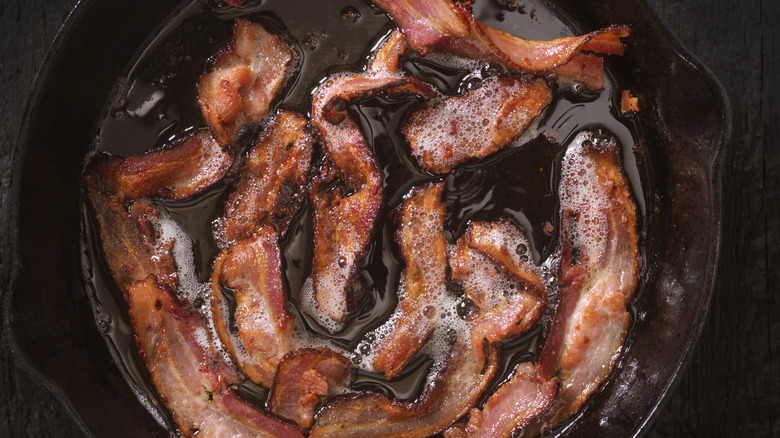15 Ways To Season Corn On The Cob
While some hardcore grillmasters flip burgers in blizzards, the rest of us just can't wait for that first shorts and t-shirt day to get the fire burning. One thing we can all agree on: The second the buds on the trees blossom, and the birds start singing, it's time to pull out the grill. Burgers, ribs, and brats tend to dominate the grill scene, but there are a few vegetables that we couldn't forget at a cookout. Corn on the cob is one of those classics we wait for all year. Yet we tend to fall into a rut when it comes to seasonings. Sure, butter, salt, and pepper are an incredible way to highlight corn's naturally sweet flavor, but variety is the spice of life, and we want to get living. There are plenty of ways to season corn on the cob, so why limit yourself?
Because corn is sweet, crunchy, juicy, and universally loved, it's not hard to find a variety of sauces, spices, and herbs that complement it beautifully. It's one of those vegetables where you can highlight the natural sugars by sweetening them up or using classically savory flavors to create contrast. Any way you slice it, corn is versatile, flavorful, and ready to get dressed up in a new way.
Hot honey
When the daring yet tantalizing combination of chicken and waffles became popularized, it had people wondering why we weren't doing more salty-sweet combinations. Then, when hot honey became the dish's condiment of choice, we knew it had reached peak perfection. Salty, sweet, and tingling spicy notes all at once had the effect of waking our taste buds from a slumber we didn't even know they were in. Well, we can achieve a similar reaction by adding that same condiment — hot honey — to corn on the cob. Corn is loaded with sugars, so the honey helps to bring those flavors to the surface, while the heat from the peppers adds a fiery kick.
If you're having trouble getting your hands on the loaded bee-made condiment, try repurposing your chili seeds to make your own homemade version. Hot honey pairs beautifully with butter (ever heard of honey butter?), as well as sea salt. Just beware that your lips don't get the full brunt of the heat when you bite into the cob!
Salt-soaked and grilled
There are a few ways to play the game if you're interested in using a salty brine to flavor grilled corn on the cob. The first is to keep the corn in the husks and soak them for at least 15 minutes, fully submerged in salt water. If you can keep them in there for longer, then by all means, do so. This technique will not only prevent the husks from burning on the grill but will promote steaming from within, producing a tender ear of corn. You can, however, expect the husks to burn slightly, as they are papery thin.
Another method, which is a super simple and preferred way to upgrade your grilled corn, is to dip the corn in brine right after it's done grilling. First, shuck your corn and let it come in direct contact with the flames. This will help to leave it slightly charred and roasted. Use the husks as a sort of handle by bunching it up at the base. Then, right when the corn is reaching perfection, dunk it into a pot of salty water. The excess water will steam off, and your corn will be sweet, saline, and slightly smokey.
Chipotle aioli
Although aioli is misunderstood, miscategorized, and often used as a term for any kind of flavored mayonnaise. However, all you need to know about aioli is that it's actually just whipped olive oil, lemon, salt, and garlic. But because the word "aioli" is often used as a blanket term for flavored mayonnaise, we can roll with that definition too. It's important to note that aioli has long been used to dress fish and vegetables, so it's very fitting to pair it with corn.
What's especially winning about this flavor profile is the dual smokey undertones of both chipotle pepper and char-grilled corn. Make your own aioli, or buy a storebought version. Mix it with freshly blended chipotle peppers (or powdered stuff if you're unable to find the canned version). Consider adding a dash of maple syrup or other sweeter to balance the heat and highlight the corn's natural sugars. However you make your chipotle aioli, drizzle it right onto your cobbed corn.
Lemon pepper rub
Classicly, lemon pepper rub is paired with seafood and mild white meats like chicken but has been known to make an appearance in the vegetable and pasta scenes from time to time. Rubs tend to work well with corn because there are so many nooks and crannies between those juicy kernels to hold all the flavor in. Use a premade lemon pepper seasoning, along with butter or olive oil, to promote sticking, or make your own from scratch.
If you're starting with the raw materials (fresh fruit), it's important to brush up on tips you need when cooking with lemon. For instance, it's important to not only use the juice but to work with the flavorful rind as well. Load up on coarsely cracked pepper and sea salt, and be sure to lay it on thick. This flavor profile works beautifully if you're serving your corn on the cob with light proteins, especially seafood.
Garlic parmesan
It's hard to argue against the dynamic duo that tastes good on pretty much anything. Garlic, for one, is an aromatic that people can't seem to get enough of. Any recipe calling for two cloves clearly meant eight, and we know that there's no way you can over-garlic (well, maybe if you're about to go on a first date or get dental work done).
A great way to be sure that your corn is properly infused with garlic is to roast the allium in the oven. Bake it right in its papery skin, loaded with olive oil, until the cloves are tender and mushy. Once cooled, squeeze the cloves from their casing to create a creamy paste. Mix this roasted garlic paste with parmesan cheese, butter, or olive oil, and a freshly minced parley. Add a little pepper and sea salt for good measure, and spread it right onto the cob. The space between the kernels will be sure to collect every last ounce of flavor.
Barbecue paprika rub and smoking chips
Barbecue enthusiasts tend to love a smokey, sweet, and savory sauce. It's a classic. In fact, a perfected homemade barbecue sauce is a huge flex and can be used in tandem with not only proteins but vegetables and even grilled fruits like pineapple. It may come as no surprise, then, that the sauce of summer pairs flawlessly with corn. But instead of simply adding barbecue sauce to corn, we recommend making a wet rub as a base layer and then lightly drizzling barbecue sauce on top so as not to overpower the natural sugars of the corn with the sweetness of the sauce.
Start by mixing paprika, chili powder, soy sauce, maple syrup or honey, olive oil, onion powder, black pepper, and garlic powder. Slather it onto your grilled corn about halfway through the grilling process to give the aromatics and spices a chance to toast. Then, lightly drizzle your favorite barbecue sauce over the corn to give it a gourmet aesthetic. Don't forget the easy method to achieve smokey barbecue flavors, and use wood-smoking chips for an ultimate rustic backyard flavor.
Pickle juice
When it comes to brine, it's natural that our heads go straight to a saline water mixture. After all, that's what we've been using for every Thanksgiving turkey, whole-roasted chicken, and even vegetables and tofu. But brine doesn't have to stop at salt and water. Consider using other salty liquid substances, like pickle juice. Leftover pickle juice has endless functions in the kitchen, from flavoring salad dressing to creating unique cocktails.
If you're a fan of the sweeter sides to Southern cuisine, then consider dunking your corn in bread and butter pickle juice. Others who prefer a tangy, herbaceous flavoring should use dill pickle juice. Simply soak your corn in the brine before grilling (with the husk on), or do a quick dip in the brine after your naked-grilled corn is fresh off the grates. Either way, you'll notice a deeper flavor than a simple salt brine has to offer. Keep in mind that you have the option to add additional layers of butter and spices as well.
Cinnamon sugar butter
When it comes to toppings, corn is just like sweet potatoes. It can go to the saccharine side just as easily as it can be savory. And while we love to load corn with flavors in the form of garlic, parsley, and paprika, there is an alternative route we can take. Consider highlighting the natural sugars in corn by slathering it in some homemade cinnamon sugar butter.
To pull this concoction together, simply mix brown sugar and a heavy dose of cinnamon into softened and salted butter. For those who prefer to spread their butter right on the cob with a knife, feel free to leave the butter soft. If you're one of those who enjoy rolling your steaming corn on the cob onto a stick of butter, then be sure to pack the mixture into a dish and re-refrigerate it until it's firm. The salty, warming spice sweetness will be an instant classic that pairs especially well with any barbecue drizzled meat, especially if you're serving up classics like cole slaw, baked beans, mac and cheese, or ribs.
Minced fresh herbs and olive oil
If you're hosting a classy, backyard farm-to-table or gastropub-style dinner (complete with patio string lights and a signature cocktail), then consider making an herby olive oil-based sauce for your corn on the cob. Hipsters are known for turning basics like burgers, fries, and pizza into gourmet meals using unique combinations. Well, corn on the cob is no exception, and like anything else, it can be classed up with a change in seasoning and plating.
Take your favorite dried herb mix and use it to infuse high-quality extra virgin olive oil, along with some minced garlic and flakey sea salt to drizzle on part-way through the grilling process. Use garlic powder or roasted garlic if you plan on steaming your corn so as to avoid the taste of raw and bitter garlic. If you have access to fresh herbs, even better. Mince herbs like basil, parsley, thyme, and rosemary are natural accents. Consider pre-toasting your rosemary and thyme to remove any bitterness.
Maple mustard
While you may have encountered maple mustard on grilled salmon or pork chop, it's actually quite versatile and can be used in a wide range of ways. In fact, map mustard can be used to elevate almost any roasted vegetable. And while drizzling the sweet and sticky syrup on vegetables might seem like an unconventional way to use maple syrup, we don't think pancakes should hog all of the fun. Consider using a pungent mustard like Dijon (or even the whole-grain version for added texture). Simply mix it with the syrup for a sharp sauce, or add a little mayonnaise or vegan mayo to mellow it with rich undertones.
Because mustard and maple syrup both carry strong flavors, we recommend using just a small drizzle in combination with your corn. This flavoring works especially well for grilled corn where smoking chips have been utilized, as maple syrup carries a caramelized flavor that blends with smoke. The spicy aspects will help to balance the sugars, and in the end, you'll have a uniquely powerful hand-held side that will have you asking for seconds and even thirds.
Classic street corn style
Where would this list of ways to season corn on the cob be without a shoutout to elote Mexican street corn? We can't forget a Mexican classic. This perfect combination of sweet, spicy, creamy, salty, and tangy is unmatched when it comes to seasoned corn on the cob. If you have a chance to try it in an authentic setting, we highly recommend you take that leap. Otherwise, gather your ingredients and make your own version at home.
You can use a grill, but a broiler works just as well to get that charred look and flavor. Rub your corn on the cob with oil, salt, and pepper before heating it up, and be sure to remove any silk and fibers so they don't catch fire. Next, mix together your crema using mayonnaise, lime juice, cheese, cilantro, and chili powder. Once your corn is out of the oven or off the grill, smother heavily with the sauce and top with fresh cilantro, cotija cheese, and Tajín seasoning.
Cajun butter
Unlike many other classic grill rubs, Cajun seasoning is primarily piquant and savory without any added sweetness. And sugar is unnecessary in this case because corn can take care of that flavor profile all on its own. Take a trip down South by whipping up your very own Cajun seasoning with spices like sweet paprika, granulated garlic, onion powder, cayenne, salt and pepper, oregano, and thyme.
This Cajun seasoning can be mixed right into soft butter as a vehicle for dressing the corn. If going this route, make a note of whether your butter is salted, and if so, eliminate or reduce the amount of salt you're adding to your spice mix. A little amount of butter will do, just enough to help the spice mixture stick to the corn. Load it on each ear right after they come out of the steamer or off the grill. Keep in mind that Cajun seasoning can be rather hot, so lick your lips often and opt for a particularly sweet variety of corn.
Garlic soy glaze
At this point, it's apparent that there are a variety of unique ways to season corn on the cob, ranging in flavors and stemming from different cultural traditions from around the world. And although corn was originally discovered and cultivated in the Americas, cultural cuisines from every corner of the earth have adapted it to fit their own flavor profiles by altering the sauces and seasonings. In fact, Asian-style corn on the cob can be quite unique, extra sweet, and incredibly flavorful.
Whip up a sauce using either miso and butter to enhance the umami flavors, or choose the sticky sweet route and make a glaze. Mix together soy sauce or tamari, minced garlic, brown sugar or maple syrup, hot chili flakes, minced ginger, lime juice, and cornstarch. Simmer the sauce and reduce it until it reaches a syrupy consistency, then drizzle ever so delicately over your freshly steamed corn on the cob. Use pronged corn holders, or be prepared to lick your fingers to get every last drop. This sauce works in combination with butter but also can be paired with sesame oil for enhanced minerality.
Old Bay and lemon mayonnaise
Let's take a trip over to Maryland, where they serve up some of the best crabs in the country. Although crab comes from the sea and corn from the earth, the two have quite a bit in common. Both the seafood and the vegetable are mild yet distinctive in flavor, have sweet undertones, and are juicy, tender, and chewy all at once. So, it's no wonder that the two can share seasonings and cooking methods and pair beautifully together.
If you're grilling fish to accompany your corn (or you live by the ocean), then look no further than Old Bay seasoning, famous in the Maryland crabbing community. A simple combination of mayonnaise, lemon juice and rind, and Old Bay seasoning can be spread generously onto your cooked corn. Old Bay seasoning is a mixture of spices you can imitate in your own kitchen, but the premade buy is excellent to have on hand. It includes things like paprika, celery salt, and red and black pepper. Either way, you'll enjoy this refreshing yet peppery seasoning on freshly cooked corn on the cob. Extra points if you pair it with classically seasoned grilled or steamed crab!
Animal fat
We are huge proponents of not wasting food when possible. That means saving your vegetable scraps to make broth, your fruit peels for infused liquor, or your animal fat for greasing a pan and adding additional flavor to a dish. Most meat drippings will do, but we especially recommend saving lamb fat, duck fat, and bacon fat. All three carry distinctive flavors and can be used to add depth and umami taste to vegetables. Just be sure to warn any vegetarians in the house of your secret ingredient.
Stop throwing out your bacon grease and instead use it to butter up your corn for grilling. This goes for any fat, as it will help protect the vegetable from drying out and give it a crispy exterior when it comes into direct contact with intense heat. In addition, animal fats are quite salty and can help to enhance the natural flavors of corn. As car as broiling in the oven goes, make sure to have a deep sides pan to reduce grease jumps and future messes.
